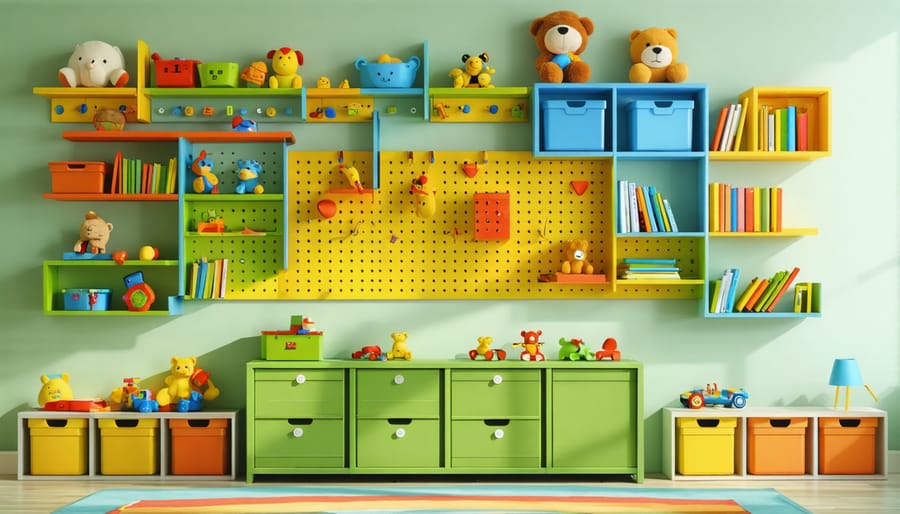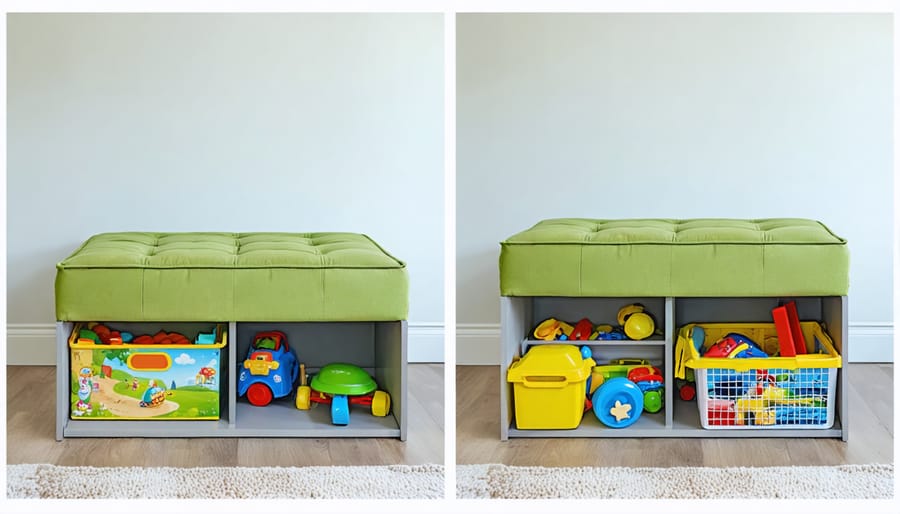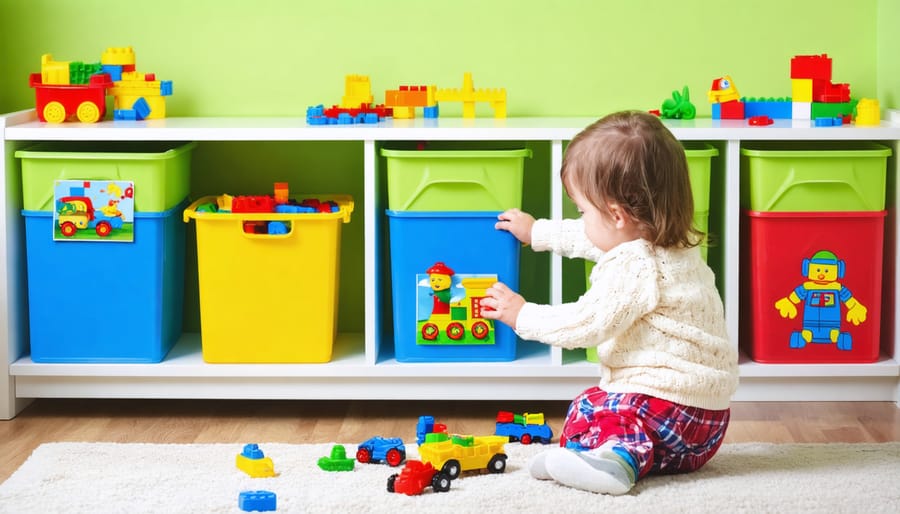Transform chaotic playrooms into organized havens by implementing smart storage solutions that teach children responsibility while helping you maximize your storage space. Install clear, labeled bins at child height to encourage independent cleanup and create instant toy categories. Mount floating shelves with colorful fabric baskets to display beloved items while keeping them easily accessible. Repurpose over-door shoe organizers into toy sorting stations, perfect for small collectibles and art supplies. Convert unused wall space into a magnetic play-and-store area using metal sheets and magnetic containers, combining entertainment with organization. These practical solutions work in spaces of any size, grow with your child’s changing needs, and maintain visual harmony in shared living areas.
Maximizing Vertical Space with Wall-Mounted Solutions
Floating Shelves and Pegboard Systems
Floating shelves and pegboard systems offer a perfect blend of storage and display, turning your child’s toys into charming room decorations. Install floating shelves at different heights to create an engaging visual arrangement while keeping toys within reach. For younger children, place frequently-used items on lower shelves and special or decorative pieces up high.
Pegboards are incredibly versatile and can be customized with hooks, baskets, and shelving attachments. Paint your pegboard in fun colors to match the room’s decor, or let your child pick their favorite shade to add a personal touch. The best part? You can easily rearrange the layout as your storage needs change.
When installing floating shelves, ensure they’re properly anchored to wall studs for maximum stability. For pegboards, leave about an inch of space between the board and the wall using spacers during installation. This gap allows hooks to slide in easily.
Consider creating activity zones by grouping similar toys together – art supplies on one shelf, building blocks on another, and books on a third. Add small containers or baskets to keep tiny pieces organized, and label everything clearly so your little one can help maintain the system.
Pro tip: Install a low floating shelf as a play surface that can be folded up when not in use, perfect for small spaces!

Over-the-Door Organizers Reimagined
Over-the-door organizers aren’t just for shoes anymore! These versatile storage solutions can transform your doorways into toy-organizing powerhouses. Try using clear pocket organizers to sort small toys by category – think action figures in one pocket, cars in another, and art supplies in the next. The transparency makes it easy for kids to find what they’re looking for and put items back where they belong.
For added functionality, consider using multiple organizers side by side on wider doors, or install them at child height for easy access. Label each pocket with pictures or words to help maintain organization, and use the higher pockets for items that need parental supervision.
Get creative with specialized pockets – mesh ones work great for bath toys that need to dry, while deeper pockets are perfect for stuffed animals and larger items. You can even dedicate certain pockets to rotating toys, keeping some hidden away to maintain novelty and prevent overwhelm.
Pro tip: Use strong adhesive hooks instead of over-door brackets for a more secure fit, especially if you have active little ones who might tug on the organizer. This also prevents door damage and allows for custom height placement.
Multi-Functional Furniture That Hides Clutter
Ottoman and Bench Storage Ideas
Storage ottomans and benches are brilliant double-duty solutions that help you create a cozy space while tackling toy clutter. These versatile pieces work exceptionally well in living rooms, playrooms, and children’s bedrooms, offering convenient seating and hidden storage in one stylish package.
Consider placing a large storage ottoman in your main living area to house frequently used toys. Look for models with safety hinges to prevent little fingers from getting pinched. For maximum organization, use smaller bins or fabric containers inside the ottoman to separate different types of toys.
Storage benches are particularly effective in entryways or along bedroom walls. Choose ones with lift-up lids for larger toys and games, or opt for models with cubby-style compartments that can hold labeled baskets. This setup makes it easy for kids to both access and put away their toys independently.
Pro tip: Select pieces with washable fabric covers or wipeable surfaces for easy maintenance. For added functionality, consider benches with divided compartments or removable organizers that help keep toys sorted. Remember to teach children the “one-out, one-in” rule to maintain organization and prevent overflow.
These furniture pieces are especially valuable in smaller homes where every square foot counts, allowing you to maximize space while maintaining a tidy, welcoming environment.

Under-Bed Storage Solutions
That often-overlooked space under the bed can become a toy storage goldmine with the right approach. Rolling containers are your best friends here – opt for clear plastic bins with wheels for easy access and visibility. The beauty of under-bed storage is that it keeps toys accessible while keeping them hidden from sight when not in use.
For a budget-friendly solution, repurpose old dresser drawers by adding casters to the bottom. Paint them in fun colors, and you’ve got instant rolling toy storage that slides effortlessly under the bed. If you’re working with a carpeted floor, consider using flat storage bags with reinforced handles instead of wheeled options.
Pro tip: Create zones under the bed by using drawer dividers or smaller containers within larger ones. This helps keep similar toys together – think building blocks in one section, action figures in another, and art supplies in a third.
To maximize vertical space, consider raising your child’s bed a few inches using bed risers. This simple adjustment can dramatically increase your storage capacity. For a more polished look, invest in purpose-built under-bed storage boxes with dust-proof lids and sturdy handles.
Remember to label everything clearly with pictures for younger children or text for older ones. This makes clean-up time more manageable and helps maintain organization long-term. A regular rotation schedule of toys from under-bed storage to active play areas can help keep things fresh and exciting for your little ones.
Clear Organization Systems That Kids Can Actually Maintain

Color-Coded Storage Bins
Color-coding isn’t just a visually appealing way to organize toys; it’s a powerful system that makes cleanup time both fun and educational for kids. By implementing kid-friendly design elements like color-coded storage bins, you’re creating an intuitive organization system that even toddlers can follow.
Start by assigning specific colors to different toy categories. For example, use red bins for building blocks, blue for art supplies, yellow for stuffed animals, and green for outdoor toys. Choose clear plastic bins or fabric containers with color-coded labels, making it easy for children to both find and put away their toys independently.
To maximize this system’s effectiveness, create a simple chart with pictures of toys and their corresponding bin colors. Post it at your child’s eye level, turning cleanup into a matching game. Consider using rainbow-order arrangement on shelves to make the storage area visually appealing while helping children learn color recognition.
Pro tip: Use consistent bin sizes when possible, and opt for stackable options to make the most of vertical space. Don’t forget to leave some bins unlabeled for flexibility as your toy collection changes. Remember to review and adjust the system every few months to ensure it continues to meet your family’s needs.
Picture Labels for Young Children
Picture labels are a game-changer when teaching young children to keep their toys organized. By combining clear images with storage bins, even pre-readers can confidently put items where they belong. Start by taking photos of the toys that belong in each container or space. Print these pictures on sturdy paper or use a laminator to make them last longer.
Attach the labels at your child’s eye level using strong adhesive or clear packing tape. For toy bins, place pictures on both the front and top for easy identification from any angle. Consider creating double-sided labels – one showing the toys that belong inside and another showing what the bin looks like when properly organized.
Make the system even more engaging by involving your children in the label-making process. Let them help take pictures or draw simple pictures of their toys. This participation creates a sense of ownership and increases the likelihood they’ll maintain the system.
For maximum effectiveness, keep labels simple and specific. Instead of a general “cars” label, show exactly which vehicles belong in that bin. Update labels seasonally or as toy collections change to maintain relevancy. Remember to include labels for spaces like reading corners, building blocks areas, and art supply stations to create a fully organized environment that your child can navigate independently.
Small Space Storage Hacks
Corner Space Maximization
Those overlooked corners in your home can become treasure troves of toy storage with the right approach. By implementing smart space-saving solutions, you can transform these often-wasted spaces into organized toy havens.
Consider installing corner floating shelves in a zigzag pattern, creating an eye-catching display that doubles as storage. These shelves work wonderfully for books, board games, and collectible toys. For floor-level storage, triangular corner units with multiple cubbies provide easy access for little ones while maximizing every inch of space.
A corner reading nook with built-in storage underneath can serve double duty – it’s both a cozy spot for storytimes and a clever hiding place for toys. Add soft cushions on top and cabinet doors or drawers below for a polished look that keeps clutter out of sight.
Don’t forget about vertical space! Corner-mounted pegboards can hold baskets and hooks for storing smaller toys, while corner tension rods with hanging organizers work great for stuffed animals and dress-up clothes. For a budget-friendly option, try stacking corner-shaped cube organizers, which can be customized with bins in different colors to match your decor.
Remember to keep frequently used toys at child height and rotate less-used items to higher shelves. This arrangement not only maximizes corner space but also helps maintain organization by making it easy for kids to both access and return their toys to their designated spots.
Vertical Rope Storage
Transform any wall into a playful storage display with a vertical rope storage system that’s both functional and visually appealing. This DIY solution is perfect for stuffed animals, soft toys, and lightweight playthings that often end up scattered across the floor.
To create your own vertical rope storage, you’ll need strong rope (preferably 1/2 inch thick), sturdy wall anchors, decorative hooks, and basic tools. Start by installing secure mounting points at the top and bottom of your chosen wall space. Thread the rope through the top hook, letting it hang naturally, and secure it at the bottom with enough tension to hold toys while maintaining a slight give.
Create “stations” along the rope by tying simple loops or adding clip-on hooks at various heights. These will serve as attachment points for your toys. Consider using different colored ropes or adding wooden beads between sections to make it more visually interesting.
Pro tip: Install the ropes at child-height to encourage independence in cleanup time. Space multiple ropes about 12 inches apart to prevent overcrowding and maintain a neat appearance.
This storage solution works particularly well in:
– Corner spaces that often go unused
– Behind doors
– Along hallway walls
– Next to beds or reading nooks
Remember to test the weight capacity of your setup and adjust the number of anchor points based on the toys you plan to hang. For extra safety, avoid hanging heavy items and ensure all mounting hardware is properly secured into wall studs or using appropriate anchors.
Creating an organized and clutter-free space for toys doesn’t have to be overwhelming or expensive. By implementing some of the storage solutions we’ve discussed, you can transform chaotic play areas into well-organized spaces that both you and your children will appreciate. Remember that the best storage system is one that your family will actually use – choose solutions that match your children’s ages, abilities, and daily routines.
Start small by implementing one or two ideas that resonate most with your situation. Whether it’s installing floating shelves, repurposing everyday items, or investing in multi-functional furniture, each step toward better organization makes a difference. Pay special attention to creating zones for different types of toys and establishing a system that’s easy for children to maintain independently.
Don’t forget that storage solutions can evolve as your children grow and their toy collections change. Regular decluttering sessions, combined with flexible storage options, will help maintain an organized space long-term. The key is finding the right balance between accessibility and tidiness while keeping safety in mind.
Most importantly, involve your children in both setting up and maintaining their toy storage systems. This not only teaches them valuable organizational skills but also gives them a sense of ownership and responsibility for their belongings. With consistency and the right storage solutions in place, you’ll find that maintaining an organized play space becomes second nature for the whole family.
